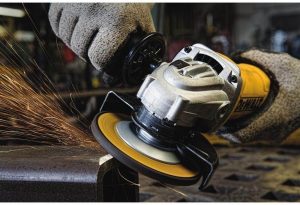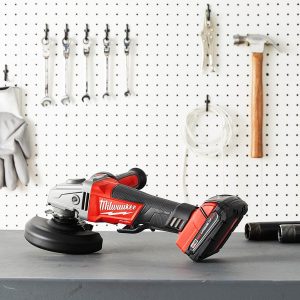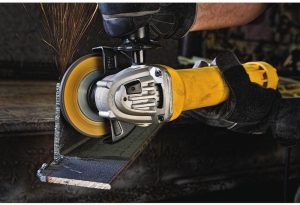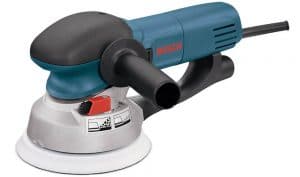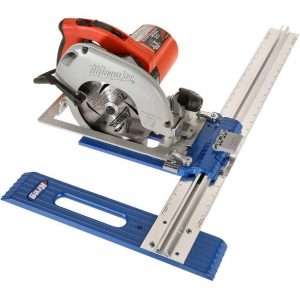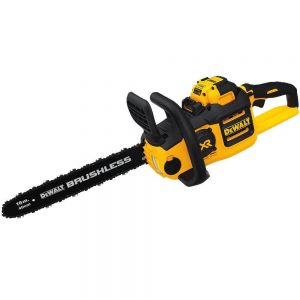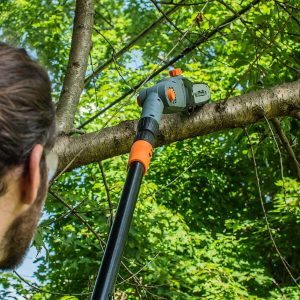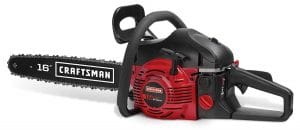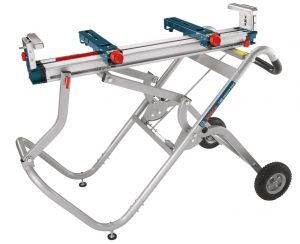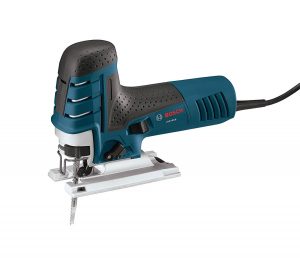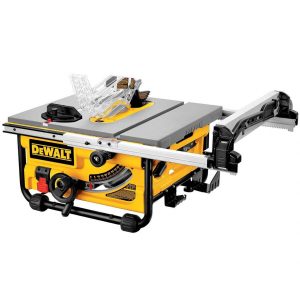Best Angle Grinders
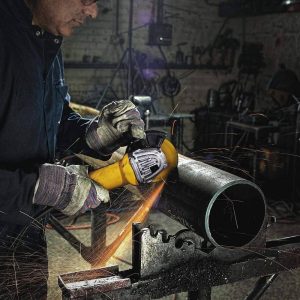
Fortunately for you, we tested 12 different models of angle grinders to bring you the best.
Read on, and we’ll show you how we picked them and which ones were up to the tests that we laid out. Not every grinder is perfect, but we’ve found some for every level of craftsman.
Our Top Pick
 Bosch 1375A
Bosch 1375A
Coming in with good power, high-quality, and great ergonomics, the Bosch 1375A is perfect for the at-home craftsman. While there are tougher out there, it flew through all of our tests with ease and performed well enough that we feel confident recommending it.
In This Article:
The 5 Top-Rated Angle Grinders
| Editor’s Picks | Brand | |
|---|---|---|
| Best Overall | Bosch 1375A | |
| Runner Up | DeWalt DWE402 | |
| Best Cordless Model | Milwaukee 2780-20 M18 Fuel | |
| The Upgrade Pick | DeWalt DCG413B | |
| Budget Pick | BLACK+DECKER BDEG400 |
Who Needs an Angle Grinder?
Angle grinders aren’t as specialized as some people seem to think. Pretty much anyone will quickly find themselves in love with their new tool.
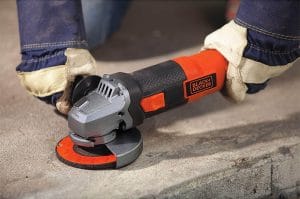
Most people will use them primarily for grinding, but they’ll also have at least one cut-off wheel around for when they need to get some serious work done.
In addition to normal usage, many people use them for more artistic purposes. They’re often used to make repetitive elements for welded statues and other pieces of artwork as well.
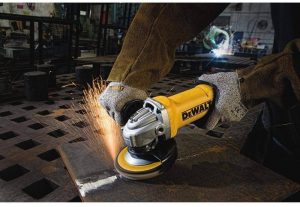
They vary a lot, but the purpose is the same: they’re used to cut and grind metal. While relatively simple, they’re a vital part of the toolkit for anyone who’s planning on working with metal.
How We Picked Our Angle Grinders
Angle grinders are a personal choice in a lot of areas, but we asked a few professional fabricators and one artisan what they look for when they’re picking a new angle grinder. We came to the following conclusions about the ideal properties.
Ergonomics
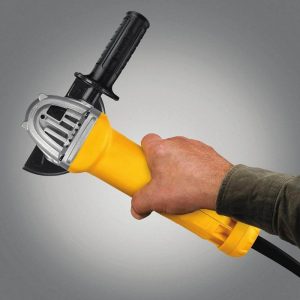
We’ll talk about safety later, but even with guards and a paddle switch, it’s control over the grinder, which will keep you safe in the end.
Switches
Angle grinders come with two kinds of switches.
A paddle switch works like a trigger. You pull it down, and the grinder spools up and does what it needs to, then you let off, and it turns off. They’re safer this way, and if you’re looking for a more powerful model, it’s the way to go.
Standard switches turn the tool on and allow you to manipulate it with both hands. The problem is that they’re a bit less safe, but if you’re careful, they can be used for some applications which are almost impossible with a paddle switch.
The choice is yours in the end, but we recommend a paddle, especially if you’re not familiar with using an angle grinder in the first place.
Power
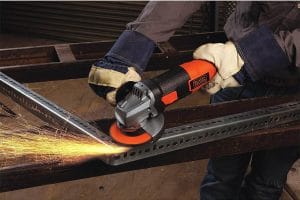
You need just enough power to get done what you’re looking to do, all of our professionals told us that too high of RPM can make an angle grinder much harder to use and not a whole lot more useful.
The sweet spot seems to be around 8-11,000 RPM. Any higher and the tool is much harder to control.
Adjustable Guards
Adjustable guards were one feature that those we interviewed agreed on unilaterally. These guards can be moved to catch sparks and chips of metal with the push of a button. All angle grinders have a guard, but the ability to move them is huge.
Sometimes you’ll be attacking a surface at an odd angle, and being able to adjust the guard for extra insurance against getting hit with flakes and sparks just makes sense. Most rotate in 90-degree increments, but that alone is a huge difference.
Overall Quality
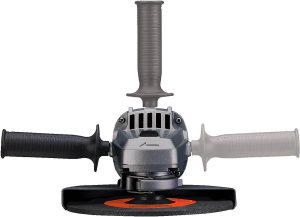
Daily or heavy weekend use is a lot different than something which only needs to be pulled out on occasion. The more you look for build quality… well, the more expensive the tool will be. However, a good angle grinder can stand up to years of abuse, so keep that in mind when you’re looking at the prices.
Corded or Cordless?
Cordless models are great for convenience, but they can only be used for a limited amount of time before needing to be recharged. A high voltage and amp-hour battery, combined with a series of batteries and careful power management, can get through a full day of work, but it’s kind of a pain.

In a fabrication shop or dedicated area to work, you’ll find that a corded model is perfect, but most people will be fine with a battery-operated grinder if that’s their choice.
The price difference is the main reason that most of those that we put in our list of top angle grinders are corded, not any real difference in power. Most people will have a plug on hand, and it just doesn’t make sense to spend that much more on a tool that does the same thing unless you really need to.
Our Testing Methods
When it came down to testing, we had to come up with a decent series of tests. We snagged a few of our reviewers who had a little bit of experience and had them report back to us after a relatively short series of tests.
We did the following with all of the grinders that we brought in:
Surface Grinding-A 2” wide piece of steel plate scrap, well seasoned with rust, had the surface ground out using a normal grinding wheel. We looked at both the time taken and the final finish of the grind to see which came out ahead.
- Cutting Metal-A simple geometric shape, in this case, an arrow was cut out of ⅛” steel with a cut-off wheel. The goal was to see how the ergonomics of the tool worked as we made the cuts, a good tool should make straight cuts easily and without requiring a lot of extra bending.
- Surface Finishing-After cutting, we actually finished the 2″ steel from the first test. We used a series of sanding wheels and finished with a polish pad to see which did the task quickly and easily.
Odd Cutting-We used some specialized wheels with those that we liked to see how they performed cutting materials like wood, concrete, and PVC. Most performed about like they did when we cut steel, but we found the more powerful models had some issues here.
Afterward, we did some general testing with scrap that was lying around to figure out which would end up being our favorites.
We decided the following five were the ones that we wanted to bring to your attention:
- The Bosch 1375A was our favorite. The combination of power, price, and ergonomics make it the best for most people’s needs.
- The DeWalt DWE402 was a great runner up. It’s a bit better built but more expensive and it needs a bit more skill to handle as it has some serious power.
- On the other hand, the Milwaukee 2780-20 M18 Fuel is a cordless beast of an angle grinder. Give it a shot if you’re wanting to ditch the cords.
- For those with the money, the battery-operated DeWalt DCG413B is an efficient, well-built machine with some extra features and a long-lasting, brushless motor. It’s a bit much for many, but it’s the way to go for a high-end grinder.
- For those who just need occasional use, there’s the BLACK+DECKER BDEG400, which is a great tool for occasional use but may not be what a professional needs.
Many of the others operated just fine, but we found these to be the cream of the crop.
Author:
Popular Articles:
Top 5 Angle Grinders
Best Overall
Bosch 1375A
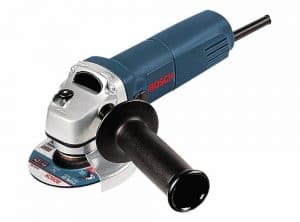
- Power: 6A
- Weight: 3.75lbs
- Cordless: No
For the average person, the 1375A is a perfect combination of price and quality. This grinder will stand up to daily use in a shop, but it’s also cheap enough that those who use it only occasionally won’t feel ripped off.
The ergonomics and light weight of this grinder were our favorite part. It easily made it through our cutting tests without holding up, and it can be angled as you’d like, thanks to the lock-on switch. That said, those who are a bit more on the cautious side may want to find something with a paddle switch.
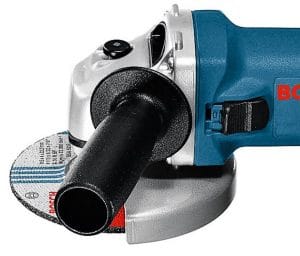
Some felt the off-switch was a bit finicky, and it has no tool storage for the wrench. The off-switch is actually a good safety feature; however, and for a shop tool, the wrench storage is less of a problem than you’d think.
Our Opinion:
For a solid angle grinder that will last for years, take a closer look at this one from Bosch. It's in a league of its own when you compare price and quality.
- Great price
- High powered
- Ergonomically sound
- Lightweight
- Corded can be a pain
- Off-switch is very touchy
Runner Up
DeWalt DWE402
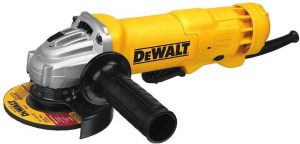
- Power: 11A
- Weight: 5lbs
- Cordless: No
This excellent angle grinder from DeWalt only didn’t make the top of our list because it’s frankly a bit much for those who aren’t used to using one. The 11.0 amp motor lets it cut, grind, and generally blaze its way through any task, but it’s also a bit shocking just how powerful it is.
This one has a trigger-style on-switch, allowing you to slowly rev up the motor if necessary. The trigger also has a “safety,” which keeps it from coming on unexpectedly as long as you’re careful about making sure it’s on when you’re done using the grinder for a moment.
Like all of the DeWalt line of tools, it’s a well-built grinder with a higher cost. The motor here isn’t brushless, unfortunately. The overall quality and assurance of the warranty are great, however.
The biggest problem we found was that it’s big. Too big for some people’s hands, but that’s to be expected considering the sheer amount of power it puts out.
Our Opinion:
For those looking for something with a lot of power and a high-quality build, this is the way to go. It's not quite the top-end of angle grinders, but it's close enough, and the price is right for the at-home DIYer.
- Very powerful motor
- Great switch
- High build quality
- Safety features
- Too powerful for some people
- Rather large for the average hand
Best Cordless Model
Milwaukee 2780-20 M18 Fuel
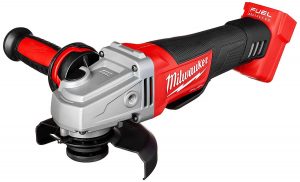
- Power: 18V
- Weight: 5lbs
- Cordless: Yes
Of all of the cordless models we tested, this one seemed to be the best. Using Milwaukee’s great batteries, it’s a doozy, and the convenience afforded by being battery-operated is hard to ignore.
The first thing we noticed was the brushless motor, of course. Brushless motors provide superior power at the same voltage due to the lessened drag inside the housing, they also tend to last longer. The only real drawback to these high-end motors is the cost.
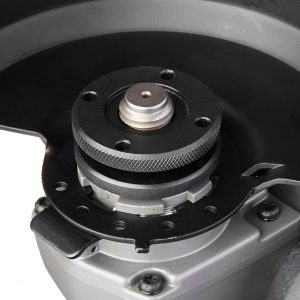
It’s expensive, of course. The handle is also a bit small for those who get iffy about using a guard but just use the guard. If you insist on taking it off, then check out our next pick.
Our Opinion:
For a cordless angle grinder, this one takes the cake. It’s high-quality, tool-less, and has a brushless motor. There’s not a whole lot more you can ask for in a cordless grinder.
- Cordless operation
- Brushless motor
- No tools needed
- High powered
- Expensive
- Handle feels a bit small
The Upgrade Pick
 DeWalt DCG413B
DeWalt DCG413B
At a Glance:
- Power: 20V
- Weight: 3.75lbs
- Cordless: Yes
For those willing to pay a premium, the DCG413B is an excellent option. This 20V angle grinder features a ton of power, a brushless motor, and superior build quality. We just feel that it’s really only suitable for professionals due to the price.
The brake was the best of all the models we tested, bringing things to a halt quickly once you let off the trigger. Extra safety features are always nice, and when you pair them with such a high-end tool, you’ve got a winner.
The side handle is robust, and while the tool is lightweight, it’s also large enough to be safe to handle. The no-load RPM rating of 9,000 is a bit misleading since it seemed to have a bit more power on the workpiece than most of the others.
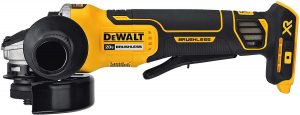
Our Opinion:
Still, this is a high-end tool with few drawbacks in the end. Take a closer look if you’re willing to put in the money for a truly magnificent angle grinder.
- Brushless motor
- 20V battery operated
- Extra safety features
- Awesome brake
- Very expensive for a bare tool
- Eats batteries quickly
Budget Pick
BLACK+DECKER BDEG400
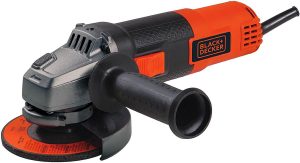
- Power: 6.5A
- Weight: 4lbs
- Cordless: No
If you just need an angle grinder for occasional usage, BLACK+DECKER has you covered. This is an excellent tool overall, outperforming some of the more expensive ones that didn’t make our list, but it lacks a bit in build-quality compared to the rest of our favorites.
It delivers power with a 6.5A motor. We wonder a bit about the rating since it doesn’t seem to be as powerful as you’d think, but it’s definitely sufficient for most tasks around the house.

The quality is mediocre when you don’t take into account the low price. It also vibrates heavily, which can be a bit off-putting for those expecting a smoother tool.
Our Opinion:
If you're looking for a budget-priced angle grinder, then this is the one you're looking for. Give it a shot, and you'll be impressed, but be aware it's not a professional tool.
- Great value for the price
- Decent power
- Repositionable handle
- Lightweight
- Mediocre build-quality
- Heavy vibrations
Safety With Your Grinder
Safety is paramount with most tools, but things can quickly go awry with an angle grinder quickly.
Proper PPE is even more important with grinders than normally. You want heavy gloves, safety glasses, and if you’re grinding heavily, even a fireproof apron is a good idea. Glasses and gloves are the big ones, though, so make sure that you’re using the right set.
The other big one that needs to be done is making sure there aren’t any flammable materials in the environment. Angle grinders throw a lot of sparks, and it’s easy to accidentally catch something on fire if you’re not careful while you’re using them.
Always use the guard as well. Some people want to remove them, but… just don’t. While it can make a job easier temporarily, the consequences of your hand contacting the blade are horrendous. A swiftly moving wheel and your fingers are a bad combination. That’s in addition to the sparks, chips, and other errant bits of the workpiece that need to be contained.
Lastly, for variable speed grinders, it’s important to find the right speed. As a general rule, you’ll want to start slow and work your way up until the material is smoothly cutting. Too high of speed can cause mistakes and make a routine job unsafe. Just be mindful when you’re pulling the trigger, and you’ll come out fine.
Angle Grinder FAQ
What accessories should I get for my angle grinder?
We suggest making sure that you have a metal cut-off wheel, a grinding wheel, and a sanding wheel to start with if you just want to be equipped for most tasks. You’ll most likely need some kind of specialty wheels at some point, but that’s enough to get you started.
Do I need an angle grinder?
If you’re planning on doing any work with steel, then an angle grinder is a must. They’re a clumsy tool for most other materials, but they can be used in a pinch for nearly any material, that said you’ll be better off with specialized tools for most materials.
Are angle grinders good for polishing?
In all honesty, they work pretty well for some applications, but they run at too high of RPMs for many materials. A dedicated polisher is a better idea for actual finish polishing, but they work fine for cleaning up work surfaces.
Are angle grinders good for sanding?
Sanding can easily be done with an angle grinder, but it’s not going to beat out something like an orbital sander in the end. Think of your grinder like a multi-tool… they’re good for pretty much everything, but they’re not the best for most applications.
Can I use an angle grinder to cut…?
Angle grinders have blade’s available to cut virtually any material. Plastic, masonry, wood, whatever. Just find the right accessory, and you’ll be good to go, but you may be better off with dedicated tools for most applications. Wood, in particular, tends to get burned due to the high RPM of angle grinders.
Grind Away, With the Right Tools
Angle grinders are a great thing to have around, with their utility really only limited by the accessories that you use them with. Thankfully they’re relatively easy to find when you’re looking for a good one. Take a look over our list; one of those is sure to be meet your needs.
Don’t wait, add one to your tool collection today!
Author:
Popular Articles:

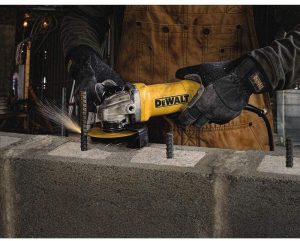 Surface Grinding-A 2” wide piece of steel plate scrap, well seasoned with rust, had the surface ground out using a normal grinding wheel. We looked at both the time taken and the final finish of the grind to see which came out ahead.
Surface Grinding-A 2” wide piece of steel plate scrap, well seasoned with rust, had the surface ground out using a normal grinding wheel. We looked at both the time taken and the final finish of the grind to see which came out ahead.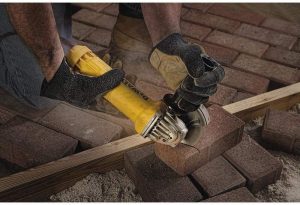 Odd Cutting-We used some specialized wheels with those that we liked to see how they performed cutting materials like wood, concrete, and PVC. Most performed about like they did when we cut steel, but we found the more powerful models had some issues here.
Odd Cutting-We used some specialized wheels with those that we liked to see how they performed cutting materials like wood, concrete, and PVC. Most performed about like they did when we cut steel, but we found the more powerful models had some issues here.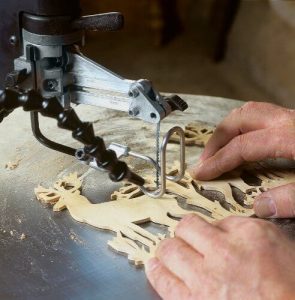
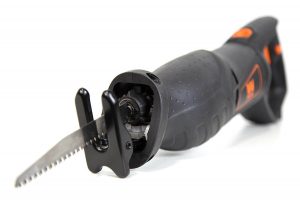
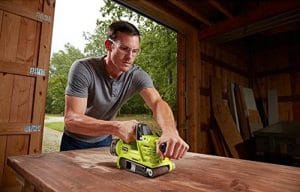
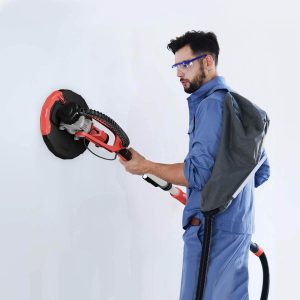
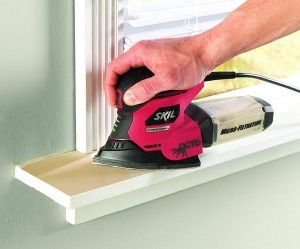
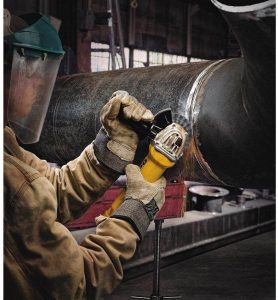
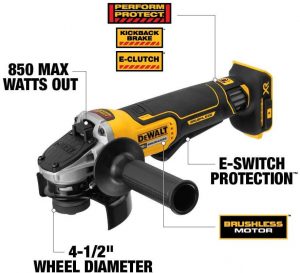 DeWalt DCG413B
DeWalt DCG413B